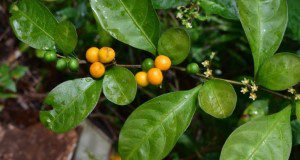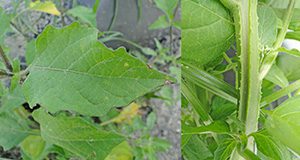Two-leaf nightshade, Solanum diphyllum, is a member of the Solanaceae or potato family. It is native to Mexico southwards to Costa Rica. It has escaped cultivation in Florida and grows as far north as Duval County and from Volusia County south to Miami-Dade County. A “bird-dispersed” volunteer, it occurs in urban and conservation areas and on disturbed land. The plants produce abundant berries with many many small seeds. This new 5-page publication of the UF/IFAS Environmental Horticulture Department is primarily intended for Florida gardeners, landscapers, and land managers, and it contains information on identification, flowering, fruiting, and management recommendations for this widely occurring plant. Written by Stephen H. Brown, Chris Marble, and Stephen F. Enloe.
https://edis.ifas.ufl.edu/ep588
Tag: Solanaceae (taxonomic family)
Biology and Management of American Black Nightshade (Solanum americanum P. Mill.) in Tomato, Pepper, Cucurbit, and Strawberry
This three-page fact sheet describes the biology and management of American black nightshade, explaining how to control for it in tomato and pepper, cucurbits, and strawberry. Written by Nathan S. Boyd, Shawn Steed, Chris Marble, and Andrew MacRae and published by the Horticultural Sciences Department.
http://edis.ifas.ufl.edu/hs1176
HS1176 American Black Nightshade Biology and Control in Fruiting Vegetables, Cucurbits, and Small Fruits
HS1176, a 3-page illustrated fact sheet by Andrew W. MacRae, describes this weed common in fruting vegetable fields, cucurbit, and strawberry production — classification, seedling identification, mature plant, management considerations, and chemical control. Includes reference. Published by the UF Department of Horticultural Sciences, May 2010.
http://edis.ifas.ufl.edu/hs1176
SS-AGR-312/AG318 Natural Area Weeds: Invasive Solanum spp. in Florida
SS-AGR-312, a 7-page illustrated fact sheet by L. T. Markle, W. A. Overholt and K. A. Langeland, provides a guide to differentiate the invasive Solanum species, information about the ecology and management of each species, and information on Solanum capsicoides All., which can easily be confused with some of the invasive Solanum species. Includes references. Published by the UF Department of Agronomy, December 2008.
http://edis.ifas.ufl.edu/AG318

